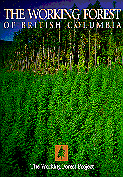

![]()

|
The Working Forest of British Columbia.
Peter Robson, Gerry Butch, and Art Walker.
Grades 10 and Up / Ages 14 to Adult.
*/4
|
excerpt:
This book is directed to the larger segment of the public which accepts the idea that part of the province's sprawling land mass should contain a ``working forest," a timber production area where some level of ecological disturbance is acceptable, as long as it is reasonable.
 The logging industry in British Columbia is big business. ``Over 70
percent of Canada's exports of sawn lumber and half of Canada's total
export of forest products comes from British Columbia." Logging in B.C.
also evokes controversy with various factions polarized either for or
against logging -- a conflict that often makes the national news.
The logging industry in British Columbia is big business. ``Over 70
percent of Canada's exports of sawn lumber and half of Canada's total
export of forest products comes from British Columbia." Logging in B.C.
also evokes controversy with various factions polarized either for or
against logging -- a conflict that often makes the national news.
. . . an excellent series of archive photos in which contemporary stands are compared with the same sites at different stages in the forest management cycle.This extensive use of high-quality colour pictures, providing ``before and after" images of B.C. logging activity, gives The Working Forest strong visual impact. The pictures prove that even heavily logged areas do return to forest. The testimonials from professional foresters that accompany the photos further strengthen the industry's argument that B.C.'s forests have never been healthier.

Not recommended.
Peter Ross Croskery is an Environmental Communications Specialist living in Grimsby, Ontario.
To comment on this title or this review, send mail to cmeditor@mts.net.
![]()
Copyright © 1996 the Manitoba Library Association.
Reproduction for personal use is permitted only if this copyright notice
is maintained. Any other reproduction is prohibited without permission.
Published by
The Manitoba Library Association
ISSN 1201-9364
![]()